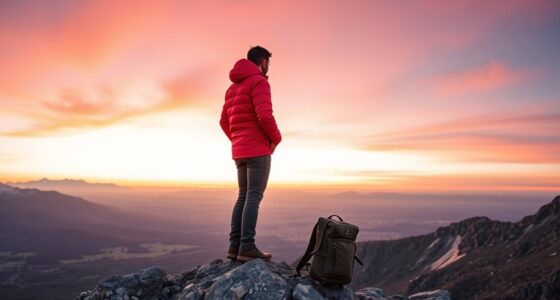Your journey to the Roof of the World begins with careful planning and training. You’ll choose between the popular Southeast Ridge route and the more challenging Northeast Ridge, facing extreme altitudes and unpredictable weather. Support from Sherpas and proper acclimatization are essential for success. As you climb past treacherous sections like the Khumbu Icefall and Hillary Step, you’ll need resilience and skill. Staying safe takes preparation—keep exploring to discover what it truly takes to conquer Everest.
Key Takeaways
- Preparing physically and mentally is crucial for tackling Everest’s extreme altitude and technical challenges.
- The most common route is via the Southeast Ridge from Nepal, involving crossing the dangerous Khumbu Icefall.
- Altitude sickness and unpredictable weather require careful acclimatization and excellent decision-making.
- Sherpas play a vital role, supporting expeditions and often summiting multiple times themselves.
- Success depends on experience, proper planning, and resilience to overcome perilous sections like the Hillary Step.

Have you ever wondered what it takes to conquer the world’s highest peak? Climbing Mount Everest is an extraordinary challenge that demands more than just physical strength—it requires meticulous planning, resilience, and a deep understanding of the mountain’s dangers. Since 1953, over 12,800 people have reached its summit, with around half of those climbs led by Sherpas, who play an essential role in supporting these expeditions. These expert climbers often summit multiple times, with some doing it ten or more times, showcasing their unmatched knowledge and stamina. Their presence is indispensable, especially considering that only about 1.7% of climbers have successfully summited without supplemental oxygen, a feat that notably increases risk but speaks to the level of skill some climbers possess. Sherpas support the majority of Everest expeditions, highlighting their critical role in ensuring safety and success on the mountain.
Climbing Everest requires skill, resilience, and expert support from Sherpas, with only 1.7% ascending without supplemental oxygen.
Your journey would likely start with choosing your route. The most popular is the Southeast Ridge from Nepal, which offers easier access and better acclimatization opportunities. Trekking to base camp on this side provides stunning scenery and a relatively gentle start, but it’s not without hazards. The Khumbu Icefall, for example, is notoriously unstable, and the Hillary Step presents a tricky obstacle near the summit. Despite these challenges, this route sees the majority of climbers—over 9,100 summits—thanks to its comparatively manageable terrain and better rescue access from villages and helicopters. Proper acclimatization and training are crucial for success, as high-altitude illness can strike unexpectedly.
Alternatively, you could attempt the Northeast Ridge from Tibet. This route is technically more demanding, with harsher weather conditions and greater exposure to cold and wind. Fewer climbers opt for this path, which means less crowding but also less support. Climbers on this side tend to be more experienced, contributing to a lower fatality rate. Additionally, the nutritional needs of climbers become critical at such extreme altitudes, and proper fueling can greatly influence endurance and safety. Maintaining proper nutrition is essential to sustain energy levels and prevent high-altitude illnesses, which can be life-threatening. Regardless of which route you choose, preparing for unpredictable weather, high-altitude dangers, and the physical toll is essential. Many climbers have succeeded, but only about 66% of expeditions reach the summit. Some manage multiple ascents within a single season, demonstrating their high endurance and adaptability to the mountain’s relentless environment.
Your climb will test your limits—each step at higher altitudes pushes your body to its maximum. The mountain’s history is filled with stories of heroism, danger, and triumph, reminding you that Everest demands respect and careful preparation. As you approach the summit, you’ll face crowds on the narrow ridge, making timing and safety paramount. Every climber’s journey is unique, but one thing is certain: reaching Everest’s summit is a profound achievement that requires a blend of skill, courage, and perseverance. Proper climbing techniques and experience are vital for navigating the most dangerous sections safely.
Frequently Asked Questions
What Inspired You to Attempt Everest?
You’re inspired to attempt Everest because you want to test your physical and mental limits, pushing yourself in one of the world’s most extreme environments. The challenge excites you, offering a chance for self-discovery, resilience, and overcoming fears. You also seek recognition, knowing reaching the summit would be an extraordinary achievement. The mountain’s allure fuels your determination, providing clarity and purpose while helping you manage emotions through a daring, life-changing adventure.
How Did You Train Physically and Mentally?
Did you know that climbers often train for over a year, dedicating 5-6 days weekly? You focus on long, uphill hikes, stair climbs, and endurance runs to build stamina, while strength training boosts your ability to carry loads. Mentally, you prepare for long, stressful days, learning to adapt to unexpected challenges. Combining physical effort with mental resilience, you develop the toughness needed to conquer Everest’s extreme conditions.
What Gear Was Essential for the Climb?
You need essential gear like a reliable ice axe, helmet, and crampons for safety and traction. Climbing boots designed for high altitude, insulated gloves, and face masks keep you warm. Use trekking poles for stability and a sturdy backpack to carry everything. Navigation tools like a GPS device, compass, and headlamp are crucial. Don’t forget a first aid kit and emergency shelter for unexpected situations, ensuring you’re prepared for the climb.
Did You Face Any Altitude Sickness?
When asked if you faced altitude sickness, you realize it’s a common risk at high elevations like Everest. You might have experienced symptoms such as headache, dizziness, or exhaustion, which are typical signs. You took precautions like gradual ascent and acclimatization, but you stayed alert for severe symptoms like confusion or difficulty breathing. Recognizing these signs early helped you manage the risks and stay safe during your incredible climb.
How Did You Handle the Mental Challenges?
You handle mental challenges by setting short-term goals to stay motivated and focused. Developing mental toughness helps you push through obstacles, while drawing on past experiences boosts your confidence. Support from fellow climbers lifts your morale, and applying mental strategies helps you manage fear and stress. Staying logistically prepared keeps your mind clear, allowing you to adapt quickly. These techniques keep you resilient amid environmental hazards and internal barriers.
Conclusion
Reaching Everest’s summit is an incredible achievement, but did you know over 300 people have died attempting it? Your journey pushes you beyond limits and tests your resolve. Climbing this majestic peak isn’t just about conquering heights; it’s about discovering strength you never knew you had. So, next time you look up at the mountain, remember—climbing Everest isn’t just a feat, it’s a affirmation to human spirit and perseverance.









